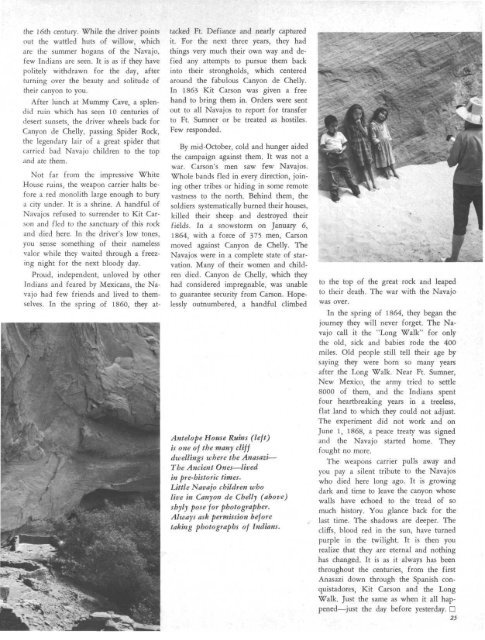Desert Magazine Book Shop - Desert Magazine of the Southwest
Desert Magazine Book Shop - Desert Magazine of the Southwest
Desert Magazine Book Shop - Desert Magazine of the Southwest
Create successful ePaper yourself
Turn your PDF publications into a flip-book with our unique Google optimized e-Paper software.
<strong>the</strong> 16th century. While <strong>the</strong> driver points<br />
out <strong>the</strong> wattled huts <strong>of</strong> willow, which<br />
are <strong>the</strong> summer hogans <strong>of</strong> <strong>the</strong> Navajo,<br />
few Indians are seen. It is as if <strong>the</strong>y have<br />
politely withdrawn for <strong>the</strong> day, after<br />
turning over <strong>the</strong> beauty and solitude <strong>of</strong><br />
<strong>the</strong>ir canyon to you.<br />
After lunch at Mummy Cave, a splendid<br />
ruin which has seen 10 centuries <strong>of</strong><br />
desert sunsets, <strong>the</strong> driver wheels back for<br />
Canyon de Chelly, passing Spider Rock,<br />
<strong>the</strong> legendary lair <strong>of</strong> a great spider that<br />
carried bad Navajo children to <strong>the</strong> top<br />
and ate <strong>the</strong>m.<br />
Not far from <strong>the</strong> impressive White<br />
House ruins, <strong>the</strong> weapon carrier halts before<br />
a red monolith large enough to bury<br />
a city under. It is a shrine. A handful <strong>of</strong><br />
Navajos refused to surrender to Kit Carson<br />
and fled to <strong>the</strong> sanctuary <strong>of</strong> this rock<br />
and died here. In <strong>the</strong> driver's low tones,<br />
you sense something <strong>of</strong> <strong>the</strong>ir nameless<br />
valor while <strong>the</strong>y waited through a freezing<br />
night for <strong>the</strong> next bloody day.<br />
Proud, independent, unloved by o<strong>the</strong>r<br />
Indians and feared by Mexicans, <strong>the</strong> Navajo<br />
had few friends and lived to <strong>the</strong>mselves.<br />
In <strong>the</strong> spring <strong>of</strong> I860, <strong>the</strong>y attacked<br />
Ft. Defiance and nearly captured<br />
it. For <strong>the</strong> next three years, <strong>the</strong>y had<br />
things very much <strong>the</strong>ir own way and defied<br />
any attempts to pursue <strong>the</strong>m back<br />
into <strong>the</strong>ir strongholds, which centered<br />
around <strong>the</strong> fabulous Canyon de Chelly.<br />
In 1863 Kit Carson was given a free<br />
hand to bring <strong>the</strong>m in. Orders were sent<br />
out to all Navajos to report for transfer<br />
to Ft. Sumner or be treated as hostiles.<br />
Few responded.<br />
By mid-October, cold and hunger aided<br />
<strong>the</strong> campaign against <strong>the</strong>m. It was not a<br />
war. Carson's men saw few Navajos.<br />
Whole bands fled in every direction, joining<br />
o<strong>the</strong>r tribes or hiding in some remote<br />
vastness to <strong>the</strong> north. Behind <strong>the</strong>m, <strong>the</strong><br />
soldiers systematically burned <strong>the</strong>ir houses,<br />
killed <strong>the</strong>ir sheep and destroyed <strong>the</strong>ir<br />
fields. In a snowstorm on January 6,<br />
1864, with a force <strong>of</strong> 375 men, Carson<br />
moved against Canyon de Chelly. The<br />
Navajos were in a complete state <strong>of</strong> starvation.<br />
Many <strong>of</strong> <strong>the</strong>ir women and children<br />
died. Canyon de Chelly, which <strong>the</strong>y<br />
had considered impregnable, was unable<br />
to guarantee security from Carson. Hopelessly<br />
outnumbered, a handful climbed<br />
Antelope House Ruins (left)<br />
is one <strong>of</strong> <strong>the</strong> many cliff<br />
dwellings where <strong>the</strong> Anasazi—<br />
The Ancient Ones—lived<br />
in pre-historic times.<br />
Little Navajo children who<br />
live in Canyon de Chelly (above)<br />
shyly pose for photographer.<br />
Always ask permission before<br />
taking photographs <strong>of</strong> Indians.<br />
to <strong>the</strong> top <strong>of</strong> <strong>the</strong> great rock and leaped<br />
to <strong>the</strong>ir death. The war with <strong>the</strong> Navajo<br />
was over.<br />
In <strong>the</strong> spring <strong>of</strong> 1864, <strong>the</strong>y began <strong>the</strong><br />
journey <strong>the</strong>y will never forget. The Navajo<br />
call it <strong>the</strong> "Long Walk" for only<br />
<strong>the</strong> old, sick and babies rode <strong>the</strong> 400<br />
miles. Old people still tell <strong>the</strong>ir age by<br />
saying <strong>the</strong>y were born so many years<br />
after <strong>the</strong> Long Walk. Near Ft. Sumner,<br />
New Mexico, <strong>the</strong> army tried to settle<br />
8000 <strong>of</strong> <strong>the</strong>m, and <strong>the</strong> Indians spent<br />
four heartbreaking years in a treeless,<br />
flat land to which <strong>the</strong>y could not adjust.<br />
The experiment did not work and on<br />
June 1, 1868, a peace treaty was signed<br />
and <strong>the</strong> Navajo started home. They<br />
fought no more.<br />
The weapons carrier pulls away and<br />
you pay a silent tribute to <strong>the</strong> Navajos<br />
who died here long ago. It is growing<br />
dark and time to leave <strong>the</strong> canyon whose<br />
walls have echoed to <strong>the</strong> tread <strong>of</strong> so<br />
much history. You glance back for <strong>the</strong><br />
last time. The shadows are deeper. The<br />
cliffs, blood red in <strong>the</strong> sun, have turned<br />
purple in <strong>the</strong> twilight. It is <strong>the</strong>n you<br />
realize that <strong>the</strong>y are eternal and nothing<br />
has changed. It is as it always has been<br />
throughout <strong>the</strong> centuries, from <strong>the</strong> first<br />
Anasazi down through <strong>the</strong> Spanish conquistadores,<br />
Kit Carson and <strong>the</strong> Long<br />
Walk. Just <strong>the</strong> same as when it all happened—just<br />
<strong>the</strong> day before yesterday. •<br />
25
















